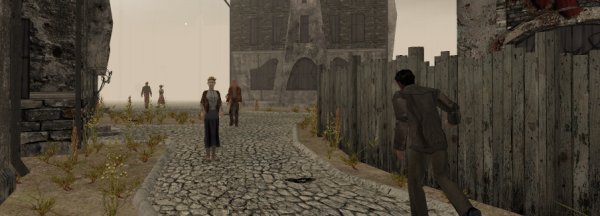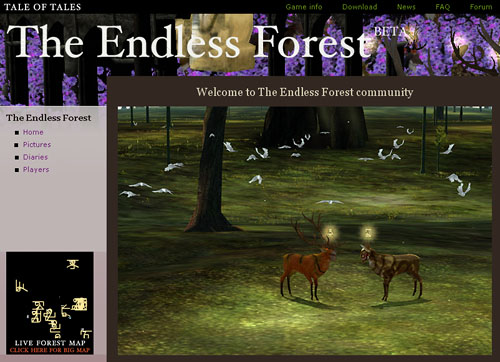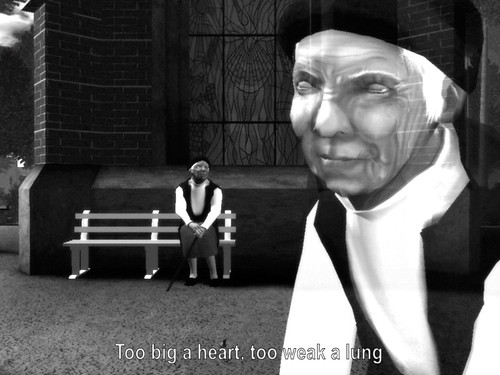The Cube Festival starts today in Issy-Les-Moulineaux, just South of Paris, France. Featuring The Endless Forest, among many other media art projects. The festival runs until 8 June.
Author: Michael
Will mobility kill the medium?

Laptop computers are becoming increasingly popular. To my great frustration because they are often underpowered machines, certainly when it comes 3D graphics, and our games require every last bit of performance they can get. But is there something else going on too?
We’ve always been very fond of the intimate nature of desktop computing. One person alone with one computer in the sollitude of their home office. That’s more or less how we imagine the ideal environment for experiencing our work (not unlike a 19th century gentleman going through his secret drawer of lewd pictures). A very intimate situation in which the player can be at ease and concentrate on the work. But as more and more people use laptop computers instead of desktops, this ideal situation will occur less and less. Through becoming mobile, computers also become trivial. Mere accessories to take on the road, for convenience, not media that you actually devote some time to.
Would cinema have been so succesfull, culturally, if it had become mobile before even maturing as a medium? I highly doubt it. It is exactly the demands that cinema makes on the viewer, that give the authors the room required to create their art. Cinema, nor literature, or theatrical or musical performances, are casual media. But if computing becomes mobile, what will be left of it as a medium?
Picture by fabuleuxfab
The Graveyard post mortem, part 2
![]()
We have finished part 2 of our article about the making of The Graveyard. After part one about how the idea was born, now it’s about getting from idea to realisation: funding and technology. Read all about how we get arts funding for our projects and how we found working with Unity3D for the first time in…
The Graveyard: How to make an idea come to life
The Graveyard post mortem
![]()
We are in the process of writing an article about the making of The Graveyard. We will be publishing each part as we finish it. Starting with Birth of an idea, about the concept of the game, where it came from and why we think it’s relevant. Next is a chapter about finding funding and technology. After that we will discuss the production itself, what went right and what went wrong. Then we will talk a bit about the important contributions of the character animator, the music composer and the sound designer. And we will conclude with an analysis of the distribution, sales, press and audience response to the game.
But first:
The Graveyard: Birth of an Idea
Enjoy!Enjoying horror…
Playing a small student game called Hush (or at least attempting to do so since I suck at any kind of challenge-based gameplay), made me realize how important the fictional aspect is for the enjoyment of horror.
Hush is a game set in Rwanda during the massacres between Hutus and Tutsis. You play a woman who is trying to silence her crying baby so that the invading soldiers don’t find them.
I have a lot of ethical issues with this game (and “news gaming” in general). And I completely disapprove of the confusion it generates between the emotions caused by the gameplay and those by the narrative. But that’s not the point here.
The soundscape of the game is incredibly effective. It’s frightening, it’s shocking. But because it is real, or pertains to a real event, I can’t seem to get the same enjoyment out of it as I might from a similar scene in an actual horror movie or game. In horror fiction, it’s fun to experience the threat of death and pain, to be overpowered by a massive and mysterious force, to be faced with a bleak and hopeless situation. But only, it would appear, within the context of fiction. Experiencing a life threatening situation in real life is not fun at all. Even imagining experiencing a horrific situation that happened for somebody else, is by no means amusing.
And yet we love horror!
Horror is not really about being frightened, is it? Experiencing real fear is not fun. What we experience in horror fiction is not real fear.
Maybe the emotion triggers the release of some chemicals in our brain that, when confronted with a real threat, help our body to respond appropriately. But when in a comfortable situation, these chemicals act like an amusing drug. Maybe all the things we do for entertainment manipulate the chemical reactions that used to be of vital importance to survival and turn them into a source of fun.
But it’s only fun if it’s fake.
Endless Forest community site is open!
We had been testing the new Endless Forest community website for a few months already. Lots of players had found their way to it. And it’s becoming a really fun place with great artworks and stories created by the community.
So we decided to just give up our perfectionism and open the site as it is, in its beta state.
Have a look:
http://EndlessForest.org
Only players of The Endless Forest can log in and post. But most of the content can be viewed by anyone.
Pathologic

We’ve been wanting to talk about the Russian studio Ice-Pick Lodge for a while now. Their 2005 game Pathologic is truly fascinating, even if it is “broken”, as John Walker put it.
Thanks to Rock Paper Shotgun we can now enjoy the game by proxy, through a grandiose triptych of a review, divided in Body, Mind and Soul.
A good read, especially with the new game, Tension, on the way.
Ice-Pick Lodge is one of those very few studios that make games from a deep artistic motivation. They don’t mess around with clever control schemes or gathering points. They have a story to tell and they use the interactive medium to tell it. Even if that means sacrificing the overrated “fun factor”. If games are ever going to become a mature artistic medium, this is where it’s going to happen.
How I wish Pathologic wouldn’t crash on my PC…
Interview with Jenova Chen
 We met with Jenova Chen and the team at Thatgamecompany for the first time at the Game Developers Conference in San Francisco last February. Their games Cloud and flOw had of course attracted our attention. And their new game under development, Flower, is looking very very interesting too. Unsurprisingly, we hit it off extremely well. But there was still much to talk about after the conference. An interview seemed like a good start to continue the conversation.
We met with Jenova Chen and the team at Thatgamecompany for the first time at the Game Developers Conference in San Francisco last February. Their games Cloud and flOw had of course attracted our attention. And their new game under development, Flower, is looking very very interesting too. Unsurprisingly, we hit it off extremely well. But there was still much to talk about after the conference. An interview seemed like a good start to continue the conversation.
This was the fastest interview we’ve ever done. We hope you’ll find it as enjoyable as we did.
Read here!
Photo by jenovachen
Emotions and art in games
In discussions about emotions in games -and the desire to have more of them- we are quick to use the word art. But outside of games, art and emotion are not so clearly linked. In fact, a lot of -“high” or “fine”- art tends to provoke much weaker emotions in the audience than soap opera’s, Hollywood tear jerkers or romantic literature. The emotions provoked by the latter evaporate rather quickly, while the former can linger on for days, years. They can even change your life, as Rilke pointed out.
Since games are interactive, we are used to receiving immediate response to our input. When it comes to emotions, we probably expect the same immediacy. We want the game to grab us by the throat and force us to feel something. Will this exclude games from ever rising above the status of popular -“low” or “commercial”- art?
I guess the question is:
Does interactivity stand in the way of depth, of thoughtfulness?
We made a new game!
We have just released The Graveyard, a very short game that we’ve been working on in secret. Its about an old lady who visits a graveyard. She walks on a path, she sits on a bench, she listens. That’s it. Except that in the full version (only $5!), she can die.
Here‘s the press release.
Download the trial now!
And support your indie game developer! 😉
read a preview/review of The Graveyard on Rock, Paper, Shotgun!
Note: the Mac version is now a Universal Binary (meaning it will run on PPC processors in addition to Intel.)


